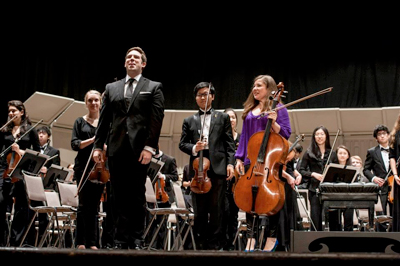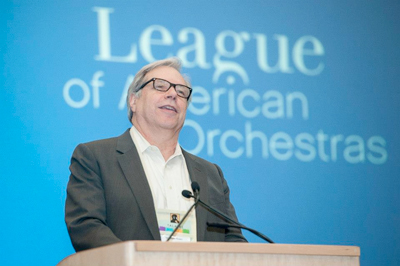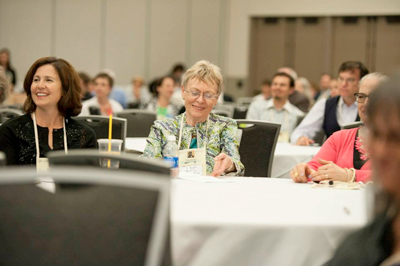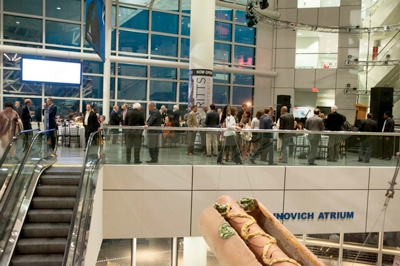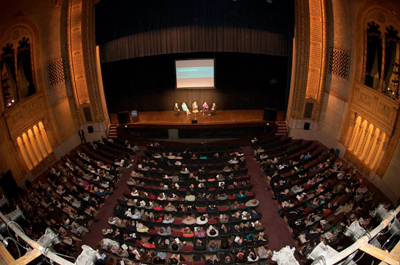by Jeremy Reynolds, Mike Telin & Daniel Hathaway
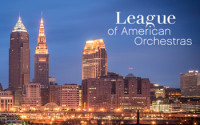
Opening events
On the first day, attendees trekked across the street from the Convention Center to Public Auditorium for the welcoming session and concert. Brett Mitchell led cellist Alisa Weilerstein and the Cleveland Orchestra Youth Orchestra in a polished performance of Saint-Saëns’s “The Swan” and a rambunctious interpretation of the “Finale” from Tchaikovsky’s fourth symphony. Weilerstein, an alumna of the youth orchestra, performed as principal cellist during the Tchaikovsky.
During CEO and League president Jesse Rosen’s opening remarks following the concert, he said, “The new is not the enemy of the old, and innovation is not the enemy of the past.” Rosen went on to explain that the conference would be a space to develop and disseminate new strategies to increase orchestras’ relevance in American communities.
Gary Hanson, Executive Director of The Cleveland Orchestra, and Leonard DiCosimo, President of the Cleveland Federation of Musicians, Local 4, shared the podium to personally welcome League attendees and to emphasize the importance of increased cooperation between orchestra management and musicians’ labor unions.
Recognizing the national impact of the League, Jane Chu, Chairman of the National Endowment for the Arts, also spoke briefly about the role of orchestras in individual communities as icons of culture and the arts.
Finally, Michael Rohd, Director of the Center for Performance and Civic Practice, moderated a discussion on the precise definition of “relevance” to set the tone for the next few days. The four panelists were Christopher Alvarado (Executive Director of the Slavic Village Development), Armond Budish (Cuyahoga County Executive), Beth Mooney (Chairman and CEO of KeyCorp), and Alisa Weilerstein (cellist, pictured above). [JR]
After the opening events, ClevelandClassical staff split up to cover as many conference sessions as possible.
Session: The Music Paradigm
Primarily interested in drawing parallels between the role of an orchestral conductor and a corporate executive, New York-based conductor Roger Nierenberg created “The Music Paradigm” program after working with community leaders to build a new concert hall. During the conference, he presented a session titled “The Music Paradigm: Demonstrating Relevance and Building Audience through the Power of Music and Metaphor.” He used film clips of his work with corporate leaders in orchestral rehearsals to demonstrate how leadership techniques in the arts applied directly to business models.
“The indirect way is the most direct way,” said Nierenberg of his allegorical teaching, insisting that increased understanding between business leaders and arts organizations would symbiotically enhance both groups’ stature in the community. [JR]
Session: Project Implementation as a Process for Learning and Improvement
Participants in the League’s Emerging Leaders Program introduced conference attendees to Reflective Practice and Action Learning. The presenters were Caleb Bailey (Orchestra Manager, Lincoln Symphony), Jennifer Barton (Individual Giving Manager, Jacksonville Symphony), Nicholas Cohen (General Manager, OrchKids and Baltimore Symphony Youth Orchestras), Brad Evans (Assistant Orchestra Personnel Manager, San Francisco Symphony), Yoo-Ji Hong (Director of Civic Orchestra and Training Programs, Chicago Symphony), Michael Reichman (General Manager, Symphony Nova), and Rebecca Zabinsky (Manager and Artistic Administrator, Houston Symphony). “Project Implementation as a Process for Learning and Improvement” focused on constant self-assessment and “learning through doing” as tools for developing successful orchestral programs in individual communities. [JR]
Session: Check this Out — Innovations from Across the Field
In this session, seven project leaders from around the country and the United Kingdom briefly introduced their recent initiatives to listeners, giving concise accounts on ventures. Initiatives ranged from the Phoenix Symphony’s “Sound of Speed,” which united the symphony with the racetrack and NASCAR in 2014, to the Richmond Symphony’s “Voices of Survival,” which featured the music of Holocaust-era composers alongside footage of Holocaust survivors living in Richmond, in partnership with Weinstein JCC and the Virginia Holocaust Museum. [JR]
Session: New Music, New Audiences
During the session entitled “New Music for New Audiences: Connecting Ideas with Communities,” composer, performer, and arts administrator Daniel Bernard Roumain launched an insightful conversation by posing the question, “Why should anyone want or need new music?” The question proved to be a good point of departure for panelists Elena Dubinets (Vice President of Artistic Planning, Seattle Symphony), Clint Needham (Composer in Residence and Professor of Music, Baldwin Wallace Conservatory), and Paola Prestini (composer) to share examples of how they have challenged themselves and their organizations to connect with audiences.
Each panelist stressed the importance of creating projects that reflect the community they are designed to serve. Needham pointed out that connecting to audiences is a long-term plan. Prestini added, “Our concert stages must look like the communities we live in.” However, as Dubinets noted, before orchestras can engage with their communities, they must first “engage internally.” The need for orchestras to plan with, and not for, their communities would be a recurring topic throughout the conference. [MT]
Session: Music that Matters
League President and CEO Jesse Rosen opened “Making Music that Matters” by quipping, “Is there music that doesn’t matter?” Panelist Delta David Gier (Music Director, South Dakota Symphony) asked, “What does community engagement mean?” Sharing insights he gained through the “Lakota Music Project,” Gier added that while it is important for orchestras to do the right thing and engage with their communities, everything must be done for the right reason and in the right way.
Shari Prentiss (Vice President of Marketing, Cincinnati Symphony) spoke about the need to discover the issues that are important to a community, such as child poverty, infant mortality, and joblessness. However, speaking about Cincinnati’s “One City, One Symphony” program, Prentiss said the next step is to figure out how an orchestra can — or if it should — play a role in addressing community issues.
David Allen Miller (Music Director, Albany Symphony) was enthusiastic about how his orchestra and the community came together by creating musical programs that re-introduced audiences to Albany’s history.
All three orchestras have figured out how to make themselves more relevant in the lives of their own communities. [MT]
Session: The Power of Collaboration
As part of “Unleashing the Power of Collaboration,” representatives of the Detroit Symphony Orchestra (Anne Parsons, Chairman Phillip Wm. Fisher & President and CEO) shared their experiences in rebuilding the orchestra and its audience through a radical approach: “putting the audience in the middle of everything we do,” and sharing responsibility through collaborations. “It’s all about people and interpersonal relationships,” they said. “We’re interdependent, and we’re nothing without each other.”
Other learnings: releasing every DSO performance digitally and for free has opened up relationships around the world. The DSO has initiated serious, mainstream activities in seven neighborhoods, offering four-concert subscriptions and encouraging people to become donors. Crises are less likely to arise now because they’re averted rather than reacted to. [DH]
Session: Digital Innovation
“Driving Growth Through Digital Innovation” featured Luke Ritchie (Digital Director, Philharmonia Orchestra), who described the orchestra’s thoroughgoing digital projects, all developed in-house. These ranged from interactive audio installations to Guitar Hero-style initiatives, and other ways of allowing the public to engage with the musicians themselves. Orchestra members and staff no longer keep paper schedules: everything the Philharmonia does is accessible online.
Jane Alexander, Chief Information Officer of the Cleveland Museum of Art, described the museum’s new digital strategies, including Gallery One (where visitors can engage digitally with all the art in the museum’s collection) and ArtLens (an app which allows you to create your own tour).
Scott Harrison, Vice President of Advancement and External Relations of the Detroit Symphony, elaborated on Fifteen Audacious Ideas to use digital technology to create a more spirited public presence for the orchestra through live webcasts of concerts (which have reached 750k viewers in 100+ countries, and 40% of the DSO’s own subscribers) and rehearsals, as well as personalized digital fundraising pitches. [DH]
Session: Public Benefits
“Public Benefits and Value of Arts and Culture” featured speakers from Cuyahoga Arts and Culture (Karen Gahl-Mills, Executive Director), re-Making Culture (Nick Rabkin, Principal), and the Seattle Symphony (Kjristine Lund, board member), who addressed the question, “Who is your community?” Panelists noted that “the public” isn’t singular, but rather a deeply fragmented population separated by a number of things. They also pointed out that it is now less white and less middle class. Public value includes a sense of place and belonging, community economic activity, social capital, and quality of life. If people don’t realize the intrinsic value of arts and culture, they won’t understand their public value.
They said that a creative renaissance is taking place among people who have a growing appetite for “learning” and “making” modes, and less appetite for the “audience” mode. People want creativity woven into their daily lives, and orchestras should work as hard at this as they do on their artistic product.
During a Q&A session, one attendee noted, “I’m a black woman who grew up in Cleveland listening B.B. King, The Beatles, Bach, and Beethoven. I live in the Inner City and love The Cleveland Orchestra, but that’s because somebody took the trouble to talk to me. If you don’t value an individual, how do you expect to have a relationship with them?” [DH]
A Conversation with Norman Lebrecht
In a plenary session, a capacity audience had the opportunity to hear a lively conversation between Gary Hanson (Executive Director, The Cleveland Orchestra) and celebrated Slipped Disc blogger Norman Lebrecht. During the 45 minutes, Hanson and Lebrecht addressed issues such as unfairness and justice in the workplace, women and orchestras, and collective bargaining. [MT]
LINKS:
Click here to view videos of several of the League sessions and a mix of presentations and transcripts. A conference photo album appears on the League of American Orchestras Facebook page (photos by Nanette Bedway, some of which are reproduced in this article).
Published on ClevelandClassical.com June 16, 2015.
Click here for a printable copy of this article



